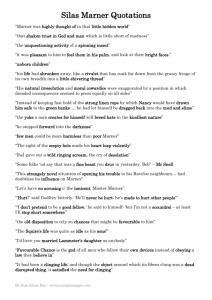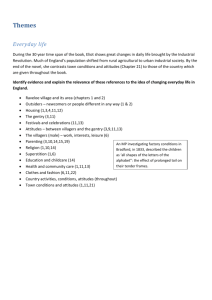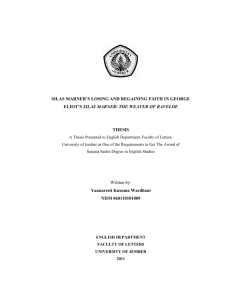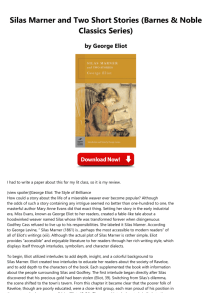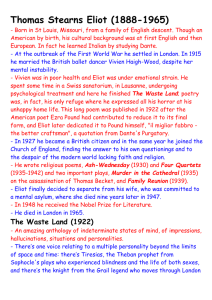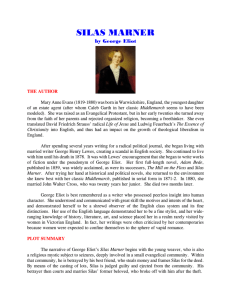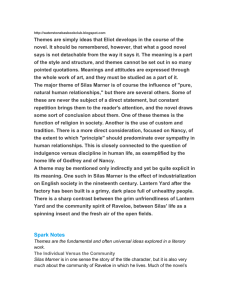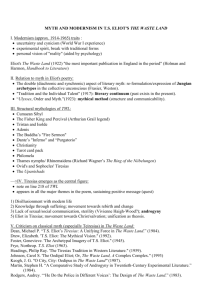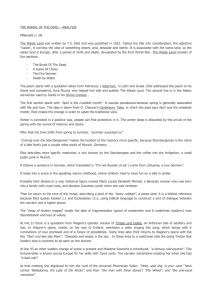Framing the fairy tale
advertisement
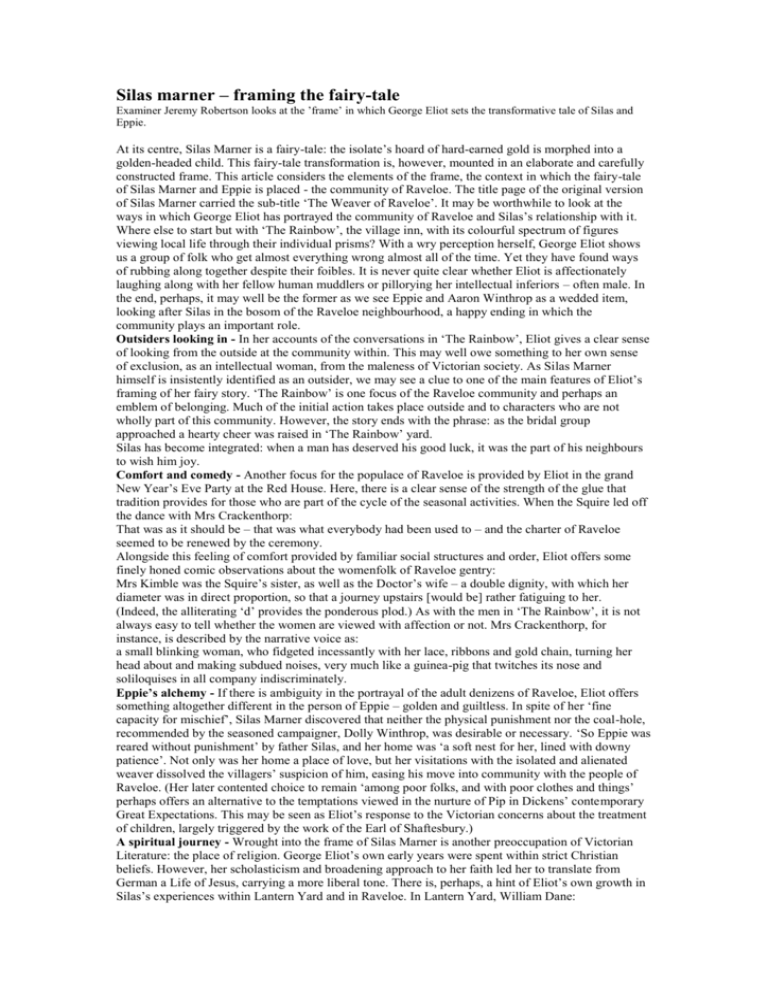
Silas marner – framing the fairy-tale Examiner Jeremy Robertson looks at the ’frame’ in which George Eliot sets the transformative tale of Silas and Eppie. At its centre, Silas Marner is a fairy-tale: the isolate’s hoard of hard-earned gold is morphed into a golden-headed child. This fairy-tale transformation is, however, mounted in an elaborate and carefully constructed frame. This article considers the elements of the frame, the context in which the fairy-tale of Silas Marner and Eppie is placed - the community of Raveloe. The title page of the original version of Silas Marner carried the sub-title ‘The Weaver of Raveloe’. It may be worthwhile to look at the ways in which George Eliot has portrayed the community of Raveloe and Silas’s relationship with it. Where else to start but with ‘The Rainbow’, the village inn, with its colourful spectrum of figures viewing local life through their individual prisms? With a wry perception herself, George Eliot shows us a group of folk who get almost everything wrong almost all of the time. Yet they have found ways of rubbing along together despite their foibles. It is never quite clear whether Eliot is affectionately laughing along with her fellow human muddlers or pillorying her intellectual inferiors – often male. In the end, perhaps, it may well be the former as we see Eppie and Aaron Winthrop as a wedded item, looking after Silas in the bosom of the Raveloe neighbourhood, a happy ending in which the community plays an important role. Outsiders looking in - In her accounts of the conversations in ‘The Rainbow’, Eliot gives a clear sense of looking from the outside at the community within. This may well owe something to her own sense of exclusion, as an intellectual woman, from the maleness of Victorian society. As Silas Marner himself is insistently identified as an outsider, we may see a clue to one of the main features of Eliot’s framing of her fairy story. ‘The Rainbow’ is one focus of the Raveloe community and perhaps an emblem of belonging. Much of the initial action takes place outside and to characters who are not wholly part of this community. However, the story ends with the phrase: as the bridal group approached a hearty cheer was raised in ‘The Rainbow’ yard. Silas has become integrated: when a man has deserved his good luck, it was the part of his neighbours to wish him joy. Comfort and comedy - Another focus for the populace of Raveloe is provided by Eliot in the grand New Year’s Eve Party at the Red House. Here, there is a clear sense of the strength of the glue that tradition provides for those who are part of the cycle of the seasonal activities. When the Squire led off the dance with Mrs Crackenthorp: That was as it should be – that was what everybody had been used to – and the charter of Raveloe seemed to be renewed by the ceremony. Alongside this feeling of comfort provided by familiar social structures and order, Eliot offers some finely honed comic observations about the womenfolk of Raveloe gentry: Mrs Kimble was the Squire’s sister, as well as the Doctor’s wife – a double dignity, with which her diameter was in direct proportion, so that a journey upstairs [would be] rather fatiguing to her. (Indeed, the alliterating ‘d’ provides the ponderous plod.) As with the men in ‘The Rainbow’, it is not always easy to tell whether the women are viewed with affection or not. Mrs Crackenthorp, for instance, is described by the narrative voice as: a small blinking woman, who fidgeted incessantly with her lace, ribbons and gold chain, turning her head about and making subdued noises, very much like a guinea-pig that twitches its nose and soliloquises in all company indiscriminately. Eppie’s alchemy - If there is ambiguity in the portrayal of the adult denizens of Raveloe, Eliot offers something altogether different in the person of Eppie – golden and guiltless. In spite of her ‘fine capacity for mischief’, Silas Marner discovered that neither the physical punishment nor the coal-hole, recommended by the seasoned campaigner, Dolly Winthrop, was desirable or necessary. ‘So Eppie was reared without punishment’ by father Silas, and her home was ‘a soft nest for her, lined with downy patience’. Not only was her home a place of love, but her visitations with the isolated and alienated weaver dissolved the villagers’ suspicion of him, easing his move into community with the people of Raveloe. (Her later contented choice to remain ‘among poor folks, and with poor clothes and things’ perhaps offers an alternative to the temptations viewed in the nurture of Pip in Dickens’ contemporary Great Expectations. This may be seen as Eliot’s response to the Victorian concerns about the treatment of children, largely triggered by the work of the Earl of Shaftesbury.) A spiritual journey - Wrought into the frame of Silas Marner is another preoccupation of Victorian Literature: the place of religion. George Eliot’s own early years were spent within strict Christian beliefs. However, her scholasticism and broadening approach to her faith led her to translate from German a Life of Jesus, carrying a more liberal tone. There is, perhaps, a hint of Eliot’s own growth in Silas’s experiences within Lantern Yard and in Raveloe. In Lantern Yard, William Dane: was regarded as a shining instance of youthful piety, though somewhat given to over-severity towards weaker brethren, and to be so dazzled by his own light as to hold himself wiser than his teachers. William Dane proved to be a scoundrel. His actions launch Silas on a spiritual journey that nears its end when Dolly Winthrop reflects that: It’s the will o’Them above as a many things should be dark to us...but doesn’t hinder there being a rights, Master Marner, for all it’s dark to you and me. The religious life of Raveloe is driven by this simple faith in the operation of external forces that deliver the seasons, and when necessary justice. Alongside this is the recognition that the people of the place need to be complementary and mutually supportive. Eliot does not offer this as a romantic pastoral idyll, but as the Christian belief in action. Acceptance of the ‘Powers That Be’ at work, as illustrated by the incurious reaction to the disappearance of Duncan Cass and Silas’s gold and their return after the passage of years, may be regarded as the expression of a ‘Duty to God’. Working together - This ‘Duty’ is conveyed by the celebration of seasonal occasions, and the rites of birth, breeding and passing, in rhythms older than those of the Christian Church. Within this awareness of the macrocosm, the members of the Raveloe community understand, albeit tacitly for the most part, the need for social interdependence. The butcher may be jolly and slow, while the farrier may be feisty and forward, but they need each other both as men and functioning workers in the community. They recognise ‘Their Duty to Their Neighbour’. To Silas Marner, the village, and the life being lived within it, is strange and to it he is (a) stranger. Eliot underlines this by ensuring that the reader registers Silas’s unusual appearance and his peculiar method of work, which relies upon his operating a complex machine rather than responding to the rhythms of the natural elements. He converts his efforts into gold, which he cherishes, but which has no great relevance to the Raveloe folk. However, it does have appeal to the roistering wastrel from ‘The Red House’ – Dunstan Cass. Eliot has constructed an intricate net of debt and obligation from the looseness of the fabric of Raveloe’s gentry’s life-style. The Cass family: could farm badly quite at their ease, drawing enough money from their bad farming...to live in rollicking fashion... The deceit surrounding Godfrey’s early marriage and the opportunity it gives for blackmail, in the context of social reputation and aspiration suggests that Eliot was less sympathetic to the presumption of the gentry than to the honest endeavour of poor, if inarticulate, villagers. The tenor of this is confirmed by Eppie’s decisive choice at the end of the tale. The contextual frame - The simple alchemy in the fairy-tale storyline of Silas Marner is thus framed in a finely crafted mounting which draws on, and echoes some of the beliefs at the heart of late eighteenth and early nineteenth century writers. Partly, it looks back to the innocence that William Blake spoke for. It owes something also to the vision of William Wordsworth, who saw man in his environment. It has some echoes of the impact of enclosures that maddened John Clare. The return to Lantern Yard implies a questioning of the key Victorian belief: that Progress is automatically a good thing, not from a Luddite, but from a perceptive human being who rates other qualities in life more highly. ‘Oh, what a dark ugly place!’ said Eppie. ‘How it hides the sky! ... I’m glad you don’t live in this town now, father.’ And Silas is dismayed when he discovers that Lantern Yard has been replaced by a big factory. ‘The old place is all swep’ away’, and there is no record of any of his old acquaintances. He no longer belongs here. Implicit in this alienation from his former habitat is George Eliot’s echo of William Blake’s horror of the ‘dark satanic mills’ invading ‘England’s green and pleasant land’. Faith is shown to be at a distance from theology: as Dolly Winthrop says things will remain ‘dark’, so the ordering of events will have to be entertained with hope. In turn, the accidents of life can be borne with shared caring; that is to say – love. The still point - The world in which George Eliot lived was a maelstrom of change. Empires were being established under what we now see as the dubious claim of bringing light into dark continents. Engineering and technology were providing physical power and expertise undreamt of. These enabled trade and communication to create wealth at the same time as they were demeaning its creators. Darwin’s ideas were threatening the most fundamental of beliefs. Just over 80 years later, in a very different social and political context, T.S. Eliot in The Four Quartets puts his finger on the crucial idea of a ‘still point of the turning world’. George Eliot in Silas Marner, places at the ‘still point of [her] turning world’ an icon: the glow of love that warms and heals. This article first appeared in emagazine 42, December 2008.
